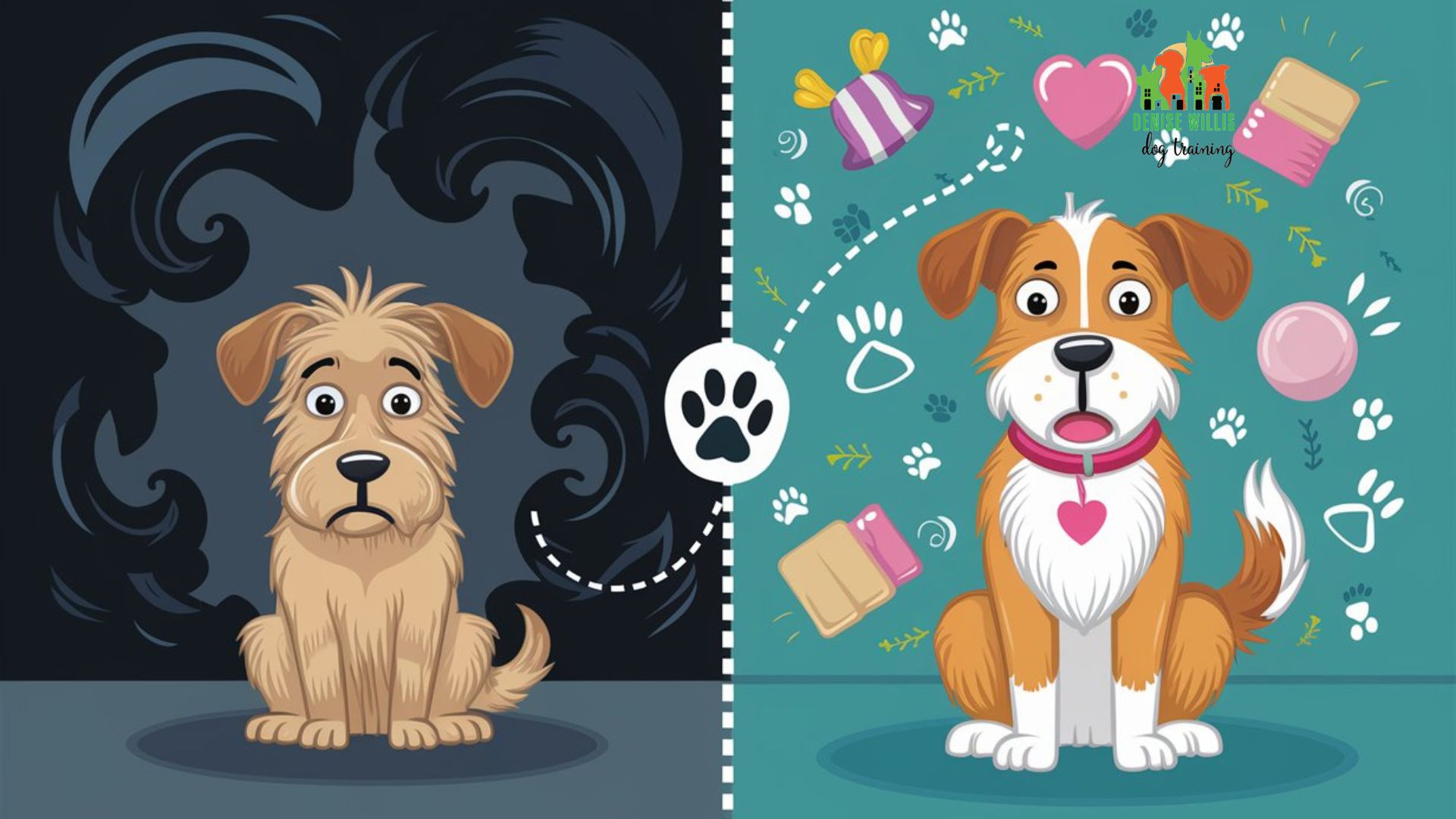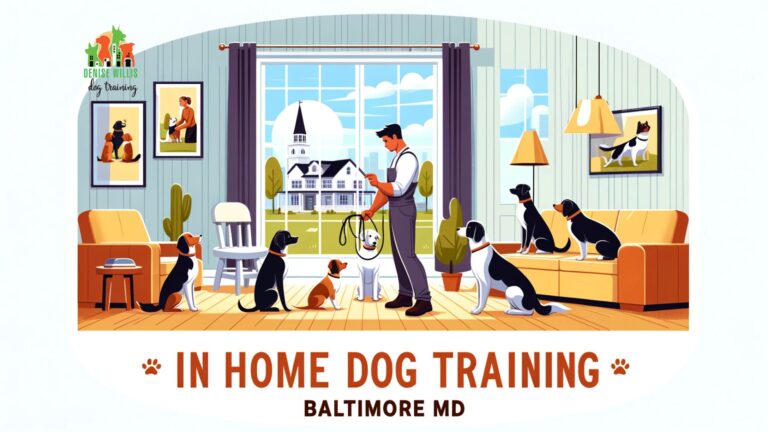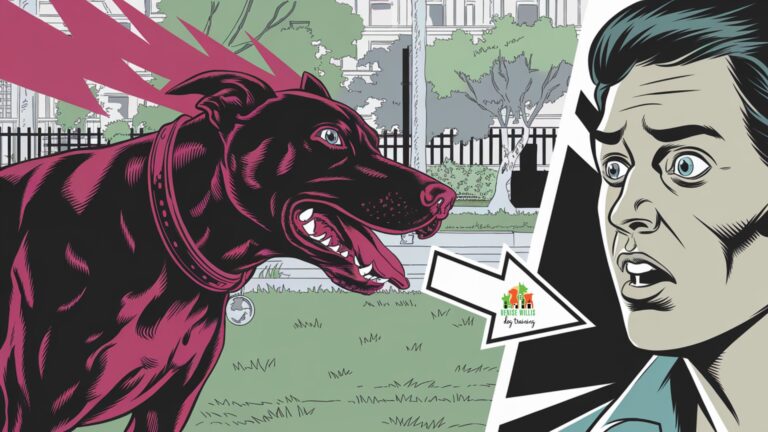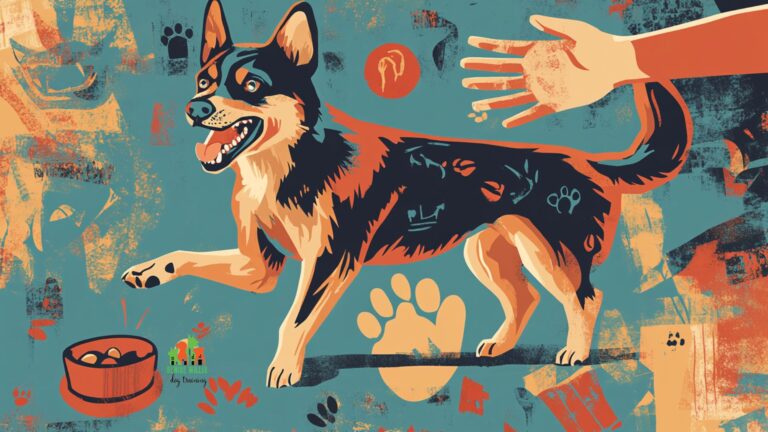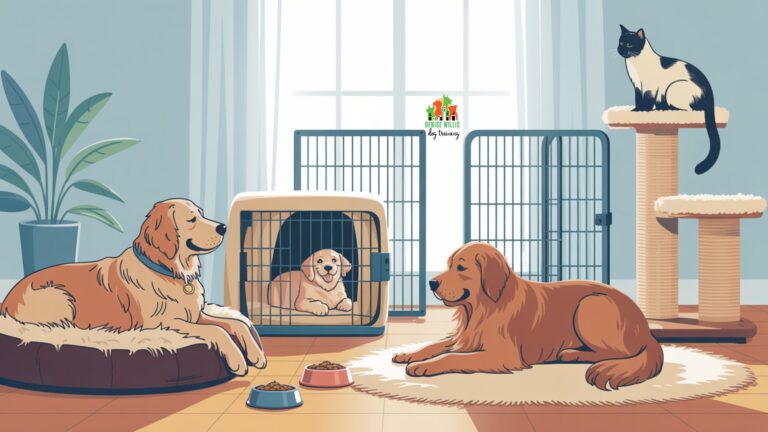From Rags to Riches: Transforming Your Rescue Dog’s Behavior
📍 Service Area Notice: DW Dog Training provides in-person training services exclusively in the Greater Baltimore area. While our blog content is designed to help dog owners internationally, our hands-on training services are locally focused. For readers outside our service area, we hope you find value in our articles and welcome you to reach out with questions!
Rescue dog behavior issues got you pulling your hair out? You’re not alone. As a dog trainer with 20 years of experience, I’ve seen countless pups go from problem child to perfect companion. But here’s the kicker: it’s not always easy, and it definitely doesn’t happen overnight. The good news?
With the right know-how, you can turn that scruffy street dog into a well-mannered family member. Whether you’re thinking about adopting or you’re already in the thick of it, stick around. I’m about to share some game-changing tips that’ll make life with your rescue dog a whole lot easier.
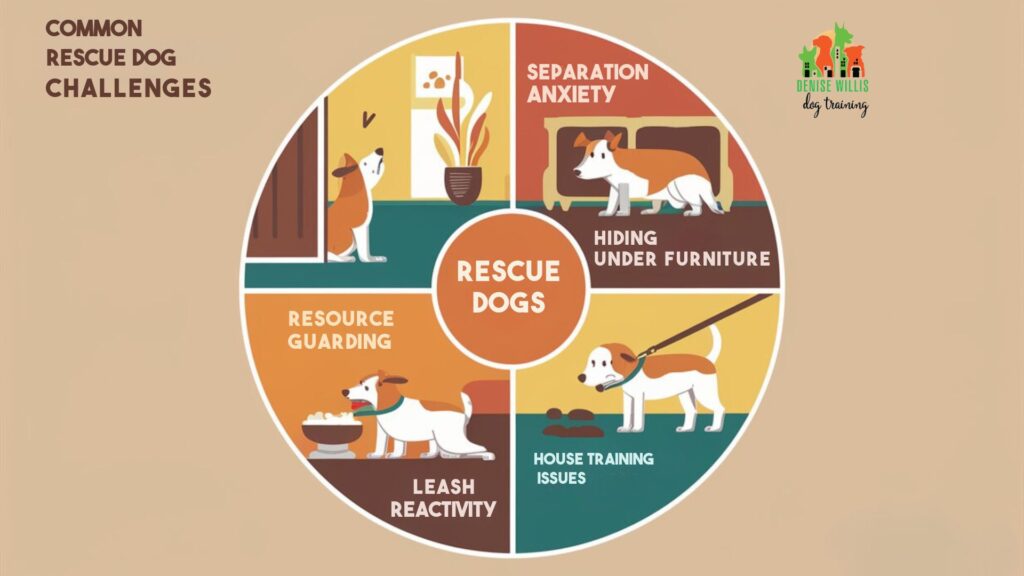
The Rescue Dog Reality Check
First things first: not every rescue dog is a bundle of problems waiting to explode. But let’s be real – many of these pups have had a rough go of it, and that can leave some emotional baggage. A recent study found some pretty interesting stats about rescue dog behavior:
| Behavior Issue | Prevalence at 6 Months Post-Adoption |
| Stranger-directed aggression | 81.7% |
| Dog-directed aggression | 75.0% |
| Separation-related behaviors | 87.5% |
| Nonsocial fear | 86.3% |
| Dog-directed fear | 67.1% |
Now, don’t let these numbers scare you off. Remember, “aggression” can mean anything from a slight growl to full-on biting, and most cases are on the milder end. Plus, with the right approach, we can work on these issues.
Common Rescue Dog Challenges
- Separation Anxiety: This is the biggie. Your new best friend might freak out when you leave, thinking you’ll never come back. Cue the howling, destructive chewing, and maybe even some accidents in the house.
Real-life example: I once worked with a Lab mix named Buddy who would literally eat through drywall when left alone. His owners were at their wit’s end. We started with short, positive alone-time training sessions, and within a month, Buddy could handle being alone for hours without demolishing the house. - Fear and Anxiety: Some rescue dogs are just plain scared of, well, everything. New people, new places, loud noises – it can all be overwhelming for a dog that hasn’t had much positive exposure to the world.
Trainer’s tip: Gradual exposure is key. Start with low-intensity versions of what scares your dog and pair it with something awesome, like their favorite treat. Slowly increase the intensity as your dog gets more comfortable. - Resource Guarding: If your pup grew up not knowing where their next meal was coming from, they might get a bit growly around food or toys.
Case study: A client’s Chihuahua, Taco, would snap at anyone who came near his food bowl. We worked on teaching Taco that people approaching meant even better treats were coming, not that his food was in danger. It took time, but Taco eventually learned to welcome people near his bowl. - Leash Reactivity: Barking, lunging, or generally losing their cool when they see other dogs or people on walks is pretty common.
Personal experience: My own rescue, Max, was a leash reactive nightmare when I first got him. We used a combination of distance work (staying far enough away from triggers that he could stay calm) and focus exercises. Now, he can walk past other dogs without batting an eye. - House Training Issues: Even adult dogs might need a refresher course on where to do their business, especially if they’ve been in a shelter for a while.
Pro tip: Treat your adult rescue like a puppy when it comes to house training. Frequent potty breaks, lots of praise for going outside, and close supervision inside until you’re sure they’ve got the hang of it.
Turning the Tide: How to Help Your Rescue Dog
Now for the good news – with patience, consistency, and maybe a little professional help, most rescue dogs can overcome these issues. Here’s your game plan:
- Set Up for Success: Create a safe, quiet space for your new pup. This could be a crate or just a comfy corner with their bed. Make it a positive place – feed them there, give them special toys there. It should be their happy place, not a punishment zone.
- Establish a Routine: Dogs thrive on predictability. Regular meal times, potty breaks, and exercise can help your rescue feel more secure. Here’s a sample schedule:
| Time | Activity |
| 7:00 AM | Wake up, potty break, breakfast |
| 8:00 AM | Walk or play session |
| 12:00 PM | Lunch, short potty break |
| 5:00 PM | Longer walk or play session |
| 6:00 PM | Dinner |
| 9:00 PM | Last potty break, bedtime |
- Slow and Steady Socialization: Gradually expose your dog to new people, places, and experiences. Keep it positive and don’t rush it. Remember, for a dog that’s had limited exposure to the world, everything can be new and potentially scary.
- Exercise Body and Mind: A tired dog is a good dog. Regular walks, playtime, and puzzle toys can help burn off energy and reduce anxiety. Aim for at least 30 minutes of physical activity and 10-15 minutes of mental stimulation daily.
- Positive Reinforcement Training: Reward the behaviors you want to see more of. This builds confidence and strengthens your bond. Clicker training can be especially effective for rescue dogs.
- Patience, Patience, Patience: Rome wasn’t built in a day, and your rescue dog won’t transform overnight. Give it time. I’ve seen dogs make amazing transformations, but it often takes months, not days or weeks.
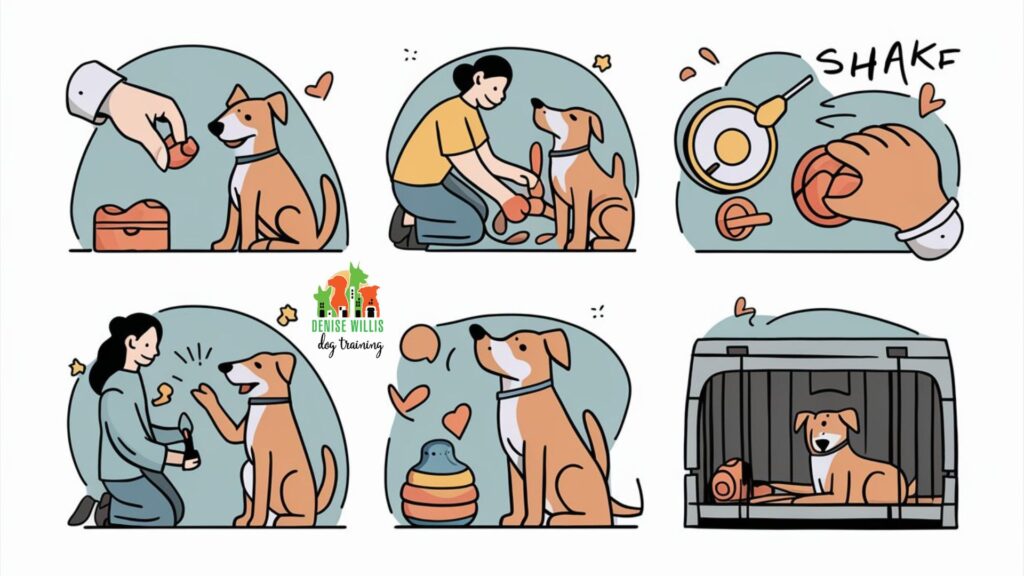
When to Call in the Pros
If you’re feeling out of your depth, don’t hesitate to reach out to a professional trainer or behaviorist. We’re here to help, especially with issues like aggression or severe anxiety that can be tricky to manage on your own.
Signs it might be time to call a pro:
- Your dog’s behavior is putting themselves or others at risk
- You’ve tried various approaches and aren’t seeing improvement
- Your dog’s issues are affecting your quality of life
- You’re feeling overwhelmed or frustrated
The Silver Lining
Here’s something cool from that study I mentioned earlier: despite all the behavior challenges, 93.7% of owners rated their rescue dog’s overall behavior as excellent or good six months after adoption. That tells me two things:
- Rescue dogs are resilient and can make amazing progress.
- The bond between a rescue dog and their new family is strong enough to outweigh the bumps along the way.
Must-Have Gear for Your Rescue Dog’s Journey
Look, I know you want to give your rescue pup the best shot at success. Over the years, I’ve found a few products that can make a real difference. Here are my top picks:
- ThunderShirt Classic Dog Anxiety Jacket: Great for calming anxious dogs during thunderstorms or fireworks.
- KONG Classic Dog Toy: Perfect for keeping your dog busy and reducing destructive chewing.
- PetSafe Easy Walk Dog Harness: Helps reduce pulling on walks without choking your pup.
- Zesty Paws Calming Bites for Dogs: A natural supplement that can help take the edge off for anxious dogs.
- Outward Hound Nina Ottosson Dog Puzzle Toy – Mental stimulation is key for rescue dogs, and this toy delivers.
These aren’t magic fixes, but they can be solid tools in your rescue dog training toolkit.
Remember, what works for one dog might not work for another, so don’t be afraid to experiment a bit.
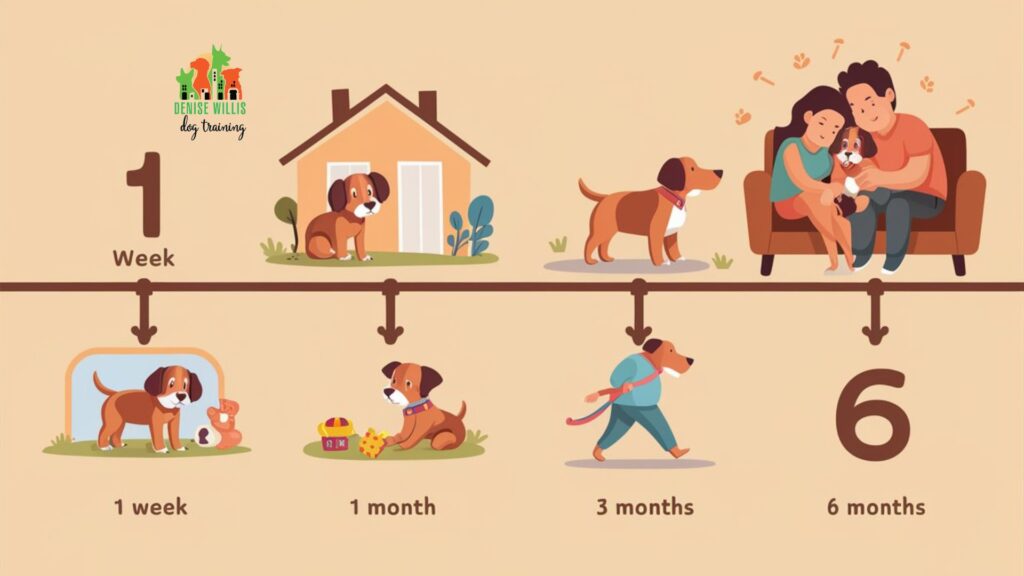
Dive Deeper: More Resources for Understanding Dog Behavior
Hey, if you’re hungry for more info on dog behavior (and let’s face it, with a rescue dog, you can never know too much), I’ve got you covered. Check out these other articles on our site:
- Dog Aggression Solutions: A Complete Guide to Stopping Aggressive Behavior in Dogs
- Causes of Dog Aggression: A Revealing Exploration into the Heartfelt Struggles of Our Furry Friends
- Signs of Aggression in Dogs: How to Identify and Respond to Them for a Harmonious Home
- Dog Aggression Toward Children: Understanding the Root Causes and Effective Solutions
These articles dive deep into specific aspects of dog behavior. They’re packed with practical advice and real-world examples.
Give them a read – you might just find that lightbulb moment you’ve been looking for in your rescue dog journey.
Key Takeaways
- Rescue dogs often come with some behavioral challenges, but these can usually be improved with patience and training.
- Common issues include separation anxiety, fear, and reactivity to other dogs or people.
- Establishing a routine, using positive reinforcement, and gradually socializing your dog can make a big difference.
- Don’t be afraid to seek professional help if you’re struggling.
- The vast majority of rescue dog owners end up very satisfied with their pups, even if there are some challenges along the way.
Frequently Asked Questions About Rescue Dog Behavior Issues
Q: How long does it take for a rescue dog to adjust to a new home? A: Every dog is different, but many start to settle in after a few weeks. Full adjustment can take several months. In my experience, you’ll see big improvements in the first month, but it can take up to 6 months for a rescue dog to fully show their true personality.
Q: Can older rescue dogs learn new behaviors? A: Absolutely! The old saying “You can’t teach an old dog new tricks” is a myth. Older dogs can be quite trainable, often with better focus than young pups. I’ve worked with 10-year-old dogs who picked up new skills faster than some puppies!
Q: What if my rescue dog isn’t bonding with me? A: Give it time. Focus on positive interactions, respect your dog’s space, and let them come to you. Some dogs take longer to form strong bonds, especially if they’ve had difficult past experiences. Try engaging in fun activities together like trick training or scent games to build your relationship.
Q: My rescue dog is aggressive towards strangers. Should I return them to the shelter? A: Before considering returning your dog, consult with a professional trainer or behaviorist. Many cases of aggression can be managed or improved with the right approach. It’s crucial to understand the root cause of the aggression and address it appropriately. Returning the dog should be a last resort after all other options have been exhausted.
Q: How can I help my rescue dog with separation anxiety? A: Start with very short absences and gradually increase the time. Use puzzle toys or long-lasting treats when you leave, and keep your comings and goings low-key. Practice “fake departures” where you go through your leaving routine but don’t actually leave. For severe cases, talk to your vet about potential medications to help the training process. Remember, this is often a long process, so patience is key.
Ready to Transform Your Rescue Dog’s Life?
Look, I’ve thrown a lot of info at you, and I know it can feel overwhelming. But here’s the thing – every rescue dog success story starts with that first step. Whether you’re struggling with leash reactivity, separation anxiety, or just want to build a stronger bond with your new furry friend, remember that you’re not alone in this journey.
At DW Dog Training, we’ve seen it all. From the most anxious pups to the rowdiest troublemakers, we’ve helped countless rescue dogs (and their humans) find their way to a happier, more balanced life together. Our motto is “Better Relationships from Better Communication,” and that’s exactly what we aim to deliver.
If you’re feeling stuck, frustrated, or just need a little extra guidance, why not give us a shout? We offer everything from in-home private training to board and train programs, all tailored to fit your dog’s unique needs and your specific goals.
Don’t let behavior issues stand in the way of the amazing relationship you and your rescue dog deserve. Take that next step today. Reach out to DW Dog Training, and let’s turn your rescue dog’s rags-to-riches story into a reality.
Ready to get started? Give us a call or fill out our contact form. Your dog’s new life is just a conversation away!
Remember, every great dog is just a little training away. Let’s make it happen together!

